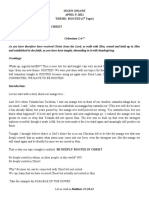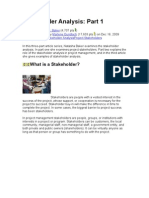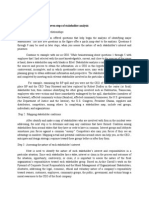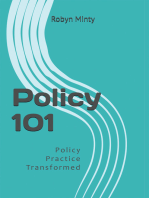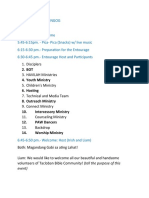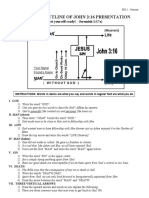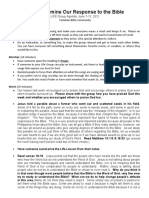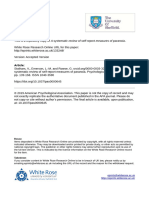0 ratings0% found this document useful (0 votes)
36 viewsStakeholder Analysis: PGI Liao, Wilfred Patrick R. Divine Word Hospital
Stakeholder Analysis: PGI Liao, Wilfred Patrick R. Divine Word Hospital
Uploaded by
Irish AlonzoThis document discusses stakeholder analysis and its steps. Stakeholder analysis is a process that systematically identifies stakeholders for a policy and analyzes their interests, knowledge, positions, power, and other characteristics. It benefits policymakers by helping them understand stakeholder viewpoints and increase support. The key steps include: 1) selecting a policy, 2) identifying stakeholders, 3) collecting stakeholder data through interviews, 4) analyzing the data in a stakeholder table, and 5) using insights to effectively engage stakeholders. The analysis identifies stakeholders' positions, interests, potential alliances, and influence to help policymakers address concerns and gain support.
Copyright:
© All Rights Reserved
Available Formats
Download as PPTX, PDF, TXT or read online from Scribd
Stakeholder Analysis: PGI Liao, Wilfred Patrick R. Divine Word Hospital
Stakeholder Analysis: PGI Liao, Wilfred Patrick R. Divine Word Hospital
Uploaded by
Irish Alonzo0 ratings0% found this document useful (0 votes)
36 views55 pagesThis document discusses stakeholder analysis and its steps. Stakeholder analysis is a process that systematically identifies stakeholders for a policy and analyzes their interests, knowledge, positions, power, and other characteristics. It benefits policymakers by helping them understand stakeholder viewpoints and increase support. The key steps include: 1) selecting a policy, 2) identifying stakeholders, 3) collecting stakeholder data through interviews, 4) analyzing the data in a stakeholder table, and 5) using insights to effectively engage stakeholders. The analysis identifies stakeholders' positions, interests, potential alliances, and influence to help policymakers address concerns and gain support.
Original Title
Stakeholder Analysis1
Copyright
© © All Rights Reserved
Available Formats
PPTX, PDF, TXT or read online from Scribd
Share this document
Did you find this document useful?
Is this content inappropriate?
This document discusses stakeholder analysis and its steps. Stakeholder analysis is a process that systematically identifies stakeholders for a policy and analyzes their interests, knowledge, positions, power, and other characteristics. It benefits policymakers by helping them understand stakeholder viewpoints and increase support. The key steps include: 1) selecting a policy, 2) identifying stakeholders, 3) collecting stakeholder data through interviews, 4) analyzing the data in a stakeholder table, and 5) using insights to effectively engage stakeholders. The analysis identifies stakeholders' positions, interests, potential alliances, and influence to help policymakers address concerns and gain support.
Copyright:
© All Rights Reserved
Available Formats
Download as PPTX, PDF, TXT or read online from Scribd
Download as pptx, pdf, or txt
0 ratings0% found this document useful (0 votes)
36 views55 pagesStakeholder Analysis: PGI Liao, Wilfred Patrick R. Divine Word Hospital
Stakeholder Analysis: PGI Liao, Wilfred Patrick R. Divine Word Hospital
Uploaded by
Irish AlonzoThis document discusses stakeholder analysis and its steps. Stakeholder analysis is a process that systematically identifies stakeholders for a policy and analyzes their interests, knowledge, positions, power, and other characteristics. It benefits policymakers by helping them understand stakeholder viewpoints and increase support. The key steps include: 1) selecting a policy, 2) identifying stakeholders, 3) collecting stakeholder data through interviews, 4) analyzing the data in a stakeholder table, and 5) using insights to effectively engage stakeholders. The analysis identifies stakeholders' positions, interests, potential alliances, and influence to help policymakers address concerns and gain support.
Copyright:
© All Rights Reserved
Available Formats
Download as PPTX, PDF, TXT or read online from Scribd
Download as pptx, pdf, or txt
You are on page 1of 55
Stakeholder Analysis
PGI Liao, Wilfred Patrick R.
Divine Word Hospital
Objectives
To define Stakeholder Analysis and Stakeholders
To discuss the benefits in doing Stakeholder Analysis
To discuss the different steps in doing Stakeholder Analysis
Stakeholder Analysis
Process of systematically gathering and analyzing qualitative information
to determine whose interests should be taken into account when
developing and/or implementing a policy or program
Who Is a Stakeholder?
These are actors (persons or organizations) with a vested interest in the policy being
promoted.
These stakeholders, or “interested parties,” can usually be grouped into the following
categories:
international/donors
national political (legislators, governors)
public (ministry of health [MOH], social security agency, ministry of finance)
labor (unions, medical associations)
commercial/private for-profit, nonprofit (nongovernmental organizations [NGOs],
foundations)
civil society
users/consumers.
Which Stakeholder Characteristics Are Analyzed?
knowledge of the policy
interests related to the policy
position for or against the policy
potential alliances with other stakeholders
ability to affect the policy process (through power and/or leadership).
Why Is Analysis Useful?
Policymakers and managers can use a stakeholder analysis to identity the
key actors and to assess their knowledge, interests, positions, alliances,
and importance related to the policy.
This allows policymakers and managers to interact more effectively with
key stakeholders and to increase support for a given policy or program.
When this analysis is conducted before a policy or program is
implemented, policymakers and managers can detect and act to prevent
potential misunderstandings about and/or opposition to the policy or
program.
Steps in Stakeholder Analysis
1. Planning the process
2. Selecting and defining a policy
3. Identifying key stakeholders
4. Adapting the tools
5. Collecting and recording the information
6. Filling in the stakeholder table
7. Analyzing the stakeholder table
8. Using the information
Step 1: Planning the Process
Define the purpose of the analysis, and identify uses for the results.
Identify and train a working group
Develop a plan and timeline.
Step 2: Selecting and Defining a Policy
Basic criteria for evaluating the appropriateness of health reform policies as
subjects of a stakeholder analysis:
The policy should be specific and “definable
The policy should be socially and politically controversial so that it merits
the investment of resources required to determine what aspects are
controversial and to whom.
The policy should be key to current reform efforts and important enough
to justify the resources that will be needed to implement recommended
actions that emerge from the analysis
Step 3: Identifying Key Stakeholders
Compile and review existing information
Develop a list of all possible stakeholders
Develop a list of priority stakeholders with input from experts.
Step 4: Adapting the Tools
Definitions of stakeholder characteristics
Stakeholder table
Interview questionnaire and protocol
Reference chart
I.D. number (given to the stakeholder on the questionnaire)
Position and organization
Internal/external: internal stakeholders work within the organization
that is promoting or implementing the policy; all other stakeholders are
external.
Knowledge of policy: the level of accurate knowledge the stakeholder
has regarding the policy under analysis, and how each stakeholder defines
the policy in question. This is important for identifying stakeholders who
oppose the policy due to misunderstandings or lack of information.
Position: whether the stakeholder supports, opposes, or is neutral about the
policy, which is key to establishing whether or not he or she will block the
policy implementation
Interest: the stakeholder’s interest in the policy, or the advantages and
disadvantages that implementation of the policy may bring to the stakeholder
or his or her organization. Determining the stakeholder’s vested interests
helps policymakers and managers better understand his or her position and
address his or her concerns.
Alliances: organizations that collaborate to support or oppose the policy.
Alliances can make a weak stakeholder stronger, or provide a way to influence
several stakeholders by dealing with one key stakeholder
Resources: the quantity of resources—human, financial, technological, political,
and other—available to the stakeholder and his or her ability to mobilize them. This
is an important characteristic that is summarized by a power index and will
determine the level of force with which the stakeholder might support or oppose the
policy
Power: the ability of the stakeholder to affect the implementation of the health
reform policy.
Leadership: the willingness to initiate, convoke, or lead an action for or against the
health reform policy. Establishing whether or not the stakeholder has leadership will
help policymakers and managers target those stakeholders who will be more likely
to take active steps to support or oppose the policy (and convince others to do so).
Suggested Interview Protocol
Two-person interview teams should be used, with the interviewers representing
different organizations whenever possible.
Both interviewers should take notes, but only one should lead the interview.
Questions should be asked no more than twice; if the stakeholder still does not
provide an answer, the interviewer should move on.
The interview should be terminated at the stakeholder’s request, even if questions
remain.
Immediately following the interview, the interviewers should type their notes into
one electronic questionnaire per stakeholder. (Interviewers should enter each
answer under its corresponding question in the electronic questionnaire.)
The information should be entered in the same words the stakeholder used.
Why do we Pretest?
Interviewers are comfortable with the questionnaire
The interviewee understands the questions
Answers provide the information required for filling in the analysis table
(the table should be filled in for the pre-test interviews)
The interview does not take more than 2 hours
Interviewers successfully adhere to the established protocol
Reference Chart
Step 5: Collecting and Recording the Information
Review existing information.
Make interview appointments.
Conduct interviews and record notes.
Step 6: Filling in the Stakeholder Table
This step of the process involves taking detailed and often lengthy
answers from the interviews and arranging them into a more concise and
systematized format (for anonymity and to highlight the most significant
information).
By doing this, the working group can eventually develop clear
comparisons among the different stakeholders and concisely present this
information to the policymakers who will use it.
Determine the stakeholders’ position
The position of each stakeholder can be established by analyzing the
following:
Information directly reported by the stakeholder in the interviews
Indirect information gathered through other stakeholders and secondary
information (i.e., others’perceptions)
Interest information.
When determining the final position of each stakeholder (column E3), the working
group needs to reconcile any differences between the position that is self-reported
(E1) and the position that is perceived by others (E2). Differences can be resolved in
the following manner:
When the stakeholder states that he or she is against the policy, this is assumed to
be accurate, albeit subjective, information because there is little incentive for the
stakeholder to misrepresent his or her position. For moderate opponents (MO) or
opponents (O), self-reporting should determine the stakeholder’s final position.
In the case of the self-reported neutral or supportive stakeholder, it is important to
cross-reference the opinions of others because the stakeholder may have an
incentive to misrepresent his or her position.
Fill in the resources column and create a power index for
each stakeholder
Quantity of resources: 3 = many, 2 = some, 1 = few
Ability to mobilize:
3 = the stakeholder can make decisions regarding the use of the resources in
his or her organization or area
2 = the stakeholder is one of several persons that can make decisions
regarding the use of resources
1 = the stakeholder cannot make decisions regarding the use of the resources.
The two resource scores for each stakeholder should be averaged,
resulting in a power index between 3 and 1: 3 = high power, 2 = medium
power, and 1 = little power
Step 7: Analyzing the Stakeholder Table
From the information in the stakeholder table, the working group should be
able to conclude the following:
Who are the most important stakeholders (from a power and leadership
analysis)?
What is the stakeholders' knowledge of the policy?
What are the stakeholders' positions on the specific policy?
What do the stakeholders see as possible advantages or disadvantages of
the policy (interest analysis)?
Which stakeholders might form alliances?
Carry out a power and leadership analysis
For this analysis, the working group should divide the stakeholders into
three groups:
Group 1: those who have leadership and high power (level 3)
Group 2: those who have leadership and medium power (level 2)
Group 3: those who do not have leadership but have high to medium
power (level 2 or 3).
Analyze knowledge data
The information found in the knowledge data can be crossed with the
power/leadership analysis to highlight the importance level of the
stakeholders with a low knowledge level.
The knowledge data also can be cross-referenced with the position of the
stakeholders to determine if those opposed to the policy have a
consistently low level of knowledge. This would indicate to the
policymaker or manager promoting this policy that communicating or
advocating the objectives and basic tenets of the policy could reduce the
opposition.
Analyze stakeholders' positions
Total number of supporters Importance of opponents (cross-reference with
Importance of supporters (cross-reference with power/leadership analysis)
power/leadership analysis) Knowledge of opponents (cross-reference with
Knowledge of supporters (cross-reference with knowledge data)
knowledge data) Advantages and disadvantages of policy
Advantages and disadvantages of policy implementation to the opponents (cross-reference
implementation to the supporters (cross-reference with interest data)
with interest data) Knowledge of whether these opponents are internal or
Knowledge of whether these supporters are internal or external to the organization developing the policy
external to the organization developing the policy (cross-reference with the internal/external
(cross-reference with the internal/external classification)
classification) Opposition "clusters": stakeholders in the same sector
Support "clusters": stakeholders in the same sector who who oppose the policy (cross-reference with
support the policy (cross-reference with organization organization information)
information) Neutral stakeholders, their importance, knowledge,
Total number of opponents and interests
Analyze interest data
In cross-referencing the interest data with other data, the policy
implementation advantages and disadvantages identified by the
stakeholders can be used to explain their positions or to emphasize their
knowledge of the policy (i.e., irrelevant advantages and disadvantages
may represent a misunderstanding of the policy).
The interest data also can be cross-referenced with the power/leadership
data to indicate what the most important stakeholders may have to lose or
gain from policy implementation
Analyze alliances
The alliances can be identified in two ways:
by referring to the analysis table to see if stakeholders mentioned
organizations that they would work with to demonstrate for or against the
policy
by referring to the position "clusters" (the stakeholders with similar
positions and within the same organization or subsector).
Analyze alliances
The alliance information should be cross-referenced with the position
data to identify those alliances that may be potential sources of support,
as well as those that may work together to oppose the policy.
The working group can suggest or encourage policymakers to develop
specific strategies based on these key alliances, either to reinforce a
potentially supportive alliance or to separate a potentially threatening
alliance.
The alliance data can also be cross-referenced with the power/leadership
analysis results to highlight those alliances that are potentially the most
supportive or threatening to the policy implementation.
Step 8: Using the Information
The use of the information generated by the stakeholder analysis should be
discussed during Step 1, Planning the Process, and should be reviewed again
once the results have been analyzed.
If the policymakers and managers plan to use the results obtained through
the stakeholder analysis to take concrete, and possibly "behind the scenes,"
actions to increase stakeholder support, only those persons involved in
implementing the follow-up actions should be included in the presentation
and discussion of the results.
If the purpose of the presentation is to share the results to build consensus
among the stakeholders, then all stakeholders should be invited to attend.
Presentation of Power/Leadership Analysis Results
Presentation of Stakeholders' Positions
Presentation of Knowledge Data
Presentation of Key Alliances
Presentation of Other Results/Conclusions
Presentation of Recommended Strategies
Presentation of Other Results/Conclusions
Presentation of Recommended Strategies
The working group presenters should always place the results within the context
of recommended actions and next steps so that the sponsor and other
policymakers or managers know how to use the results.
To guide these follow-up actions, the working group should develop strategies to
achieve the following five basic goals:
Maintain the support of those stakeholders who are currently supporters
Increase power and leadership of the supporters
Convert the opponents to supporters
Weaken the power and leadership of the opponents
Convert the neutral stakeholders into active supporters (i.e., convince them to
support the policy and increase their power and leadership where necessary).
Two types of strategies can then be identified to meet those goals:
General strategies: the working group should analyze the interests,
concerns, and misunderstandings common to most stakeholders.
Strategies for specific stakeholder groups: the working group should
consider the position of each stakeholder, his or her interests, and the five
basic strategy goals. The working group should develop specific ways of
addressing the concerns of the individual stakeholders and securing their
active support (i.e., increasing their power and leadership so they can
demonstrate this support).
The working group should present these strategies to the sponsor and other
policymakers or managers present, with the following caveats:
To be most effective, certain strategies may need to remain confidential, known
only by a select group of policymakers implementing the policy.
The strategies should be developed in further detail through concrete action
plans, communication plans, and negotiation packages.
The implementation of the strategies will require the commitment of additional
time and resources from the sponsor.
The implementation of the strategies will require the development of a select
group of professionals trained in communication, facilitation and mediation,
and negotiation techniques.
It is not always necessary or feasible to implement all of the strategies
immediately. In presenting the strategies, the working group should
identify a few, select priorities for immediate action (i.e., next steps) by
the sponsor or other policymakers or managers.
Depending on the results, the working group may recommend
implementation of one key strategy for all stakeholders, or
implementation of several strategies to address the needs of several
stakeholders. In the latter case, the working group should recommend
which stakeholders should be targeted for strategy implementation, given
the limited resources generally available for implementation.
Stakeholders To Be Targeted by Strategies
Supporters with little power and leadership: focus on ways of increasing
the power and leadership of these stakeholders.
Neutral stakeholders with medium to high power and leadership: focus
on convincing the stakeholders to support the policy and increasing their
power and leadership where necessary.
Opponents with high power and leadership: focus on negotiating for the
opponents' support and decreasing their power and leadership if they
remain opposed.
Reference
You might also like
- 16 Crosby and Brinkerhoff - Stakeholder AnalysisDocument7 pages16 Crosby and Brinkerhoff - Stakeholder AnalysisBeverly Abriol100% (1)
- Health Communication: From Theory to PracticeFrom EverandHealth Communication: From Theory to PracticeRating: 5 out of 5 stars5/5 (2)
- From Cursed To Blessed EGR 2022Document4 pagesFrom Cursed To Blessed EGR 2022Irish AlonzoNo ratings yet
- Political AnalysisDocument7 pagesPolitical AnalysisjunzNo ratings yet
- Stakeholder AnalysisDocument30 pagesStakeholder AnalysisVishwesh Koundilya100% (1)
- Guidelines Conducting Stakeholder AnalysisDocument42 pagesGuidelines Conducting Stakeholder AnalysisDavid Sigalingging100% (1)
- Public Policy AnalysisDocument4 pagesPublic Policy AnalysisIvy CorpuzNo ratings yet
- Handout Stakeholders Analysis, SWOT, TOWS MatrixDocument5 pagesHandout Stakeholders Analysis, SWOT, TOWS MatrixJoey HernandezNo ratings yet
- The Role of Stakeholders in CSRDocument5 pagesThe Role of Stakeholders in CSRJade Saren BaronNo ratings yet
- Ingen Online APRIL 9, 2021 Theme: Rooted (1 Topic) Title: Be Deeply Rooted in Christ Main VerseDocument8 pagesIngen Online APRIL 9, 2021 Theme: Rooted (1 Topic) Title: Be Deeply Rooted in Christ Main VerseIrish AlonzoNo ratings yet
- Edexcel Psychology A-Level Sample-ChapterDocument16 pagesEdexcel Psychology A-Level Sample-Chapterus467% (3)
- Stakeholder AnalysisDocument8 pagesStakeholder AnalysiskokojerryNo ratings yet
- Stakeholder AnalysisDocument30 pagesStakeholder Analysismanuel_flores_120100% (8)
- SW 104Document33 pagesSW 104Jay YeeNo ratings yet
- Cross Cutting Tool Stakeholder Analysis by Eunice ReanzaresDocument6 pagesCross Cutting Tool Stakeholder Analysis by Eunice ReanzaresJannahSalazarNo ratings yet
- Policy AnalysisDocument3 pagesPolicy AnalysisIrine BrionesNo ratings yet
- Stakeholder AnalysisDocument8 pagesStakeholder AnalysisMohammad Khurshaid AhmadNo ratings yet
- Stakeholder Analysis StepsDocument2 pagesStakeholder Analysis StepsgheljoshNo ratings yet
- Handout 4.1 Stakeholder AnalysisDocument8 pagesHandout 4.1 Stakeholder AnalysisJohn McArdleNo ratings yet
- Stakeholder Management Plan Template: Introduction: How To Use This TemplateDocument5 pagesStakeholder Management Plan Template: Introduction: How To Use This TemplateErendira PerezNo ratings yet
- Stakeholder Analysis Crosby PDFDocument7 pagesStakeholder Analysis Crosby PDFLuis José Murillo TigreroNo ratings yet
- How To Make Policy AnalysisDocument9 pagesHow To Make Policy AnalysisJijng VillegasNo ratings yet
- Instructions: Policy-Analysis - Html#Ixzz1ByamiwsxDocument3 pagesInstructions: Policy-Analysis - Html#Ixzz1ByamiwsxarunsaviNo ratings yet
- Cliant User LiaisonDocument20 pagesCliant User LiaisonDo DothingsNo ratings yet
- Task 11Document5 pagesTask 11David EspinozaNo ratings yet
- Plan Stakeholder EngagementDocument6 pagesPlan Stakeholder Engagementfarzad.jahangNo ratings yet
- MDF Tool: Stakeholder Analysis: What Is It?Document5 pagesMDF Tool: Stakeholder Analysis: What Is It?enpes0% (1)
- wp4 n21-01 Stakeholder Analysis ReportDocument25 pageswp4 n21-01 Stakeholder Analysis ReportSamuel Getaneh TNo ratings yet
- What Is Stakeholder Analysis?Document10 pagesWhat Is Stakeholder Analysis?Ramprasad BonamNo ratings yet
- ENGLISH - 20-21 - PR - Course Module (Theory 4)Document23 pagesENGLISH - 20-21 - PR - Course Module (Theory 4)daraNo ratings yet
- Tools in Policy Analysis 23-24Document24 pagesTools in Policy Analysis 23-24rafael baesaNo ratings yet
- Pse (Participatory Stakeholder Engagement)Document8 pagesPse (Participatory Stakeholder Engagement)Bhagya KrishnaNo ratings yet
- Policy Change CycleDocument29 pagesPolicy Change CycleReg LagartejaNo ratings yet
- Ch 5 Stakeholder AnalysisDocument17 pagesCh 5 Stakeholder Analysisshahsakibsadmanpranto1873No ratings yet
- Suryaansh SlathiaDocument13 pagesSuryaansh SlathiaSuryaansh SlathiaNo ratings yet
- Topic 3Document3 pagesTopic 3Bramwel WanyonyiNo ratings yet
- COMM 306 Advisory Report Guidelines 2021-22 T3Document5 pagesCOMM 306 Advisory Report Guidelines 2021-22 T3Amtul AyoubNo ratings yet
- Stakeholder Power Tool EnglishDocument24 pagesStakeholder Power Tool EnglishkokojerryNo ratings yet
- Policy Development and AnalysisDocument18 pagesPolicy Development and Analysisفيصل الاعرجNo ratings yet
- Measure Political WillDocument32 pagesMeasure Political WillAhmed JawadNo ratings yet
- Four Steps in Managing Stake HoldersDocument6 pagesFour Steps in Managing Stake Holderskashif salman100% (2)
- Policy Making The Science of Decisions - Mendoza, Lorenzo AntonioDocument41 pagesPolicy Making The Science of Decisions - Mendoza, Lorenzo AntonioLanz Mendoza100% (3)
- Writing A Policy AnalysisDocument10 pagesWriting A Policy AnalysiskimdaveNo ratings yet
- Result - 9 - 2 - 2023, 11 - 29 - 36 AMDocument7 pagesResult - 9 - 2 - 2023, 11 - 29 - 36 AMabhishek majiNo ratings yet
- Define Health Policy and Describe Health Policy Formulation ProcessDocument3 pagesDefine Health Policy and Describe Health Policy Formulation ProcessShafaq MahmoodNo ratings yet
- Stakeholder Analysis and ManagementDocument5 pagesStakeholder Analysis and Managementsee1tear100% (1)
- 11. Understanding the environmentDocument9 pages11. Understanding the environmentHALAKATTI.S.V.10676 5200No ratings yet
- Advocacy: Strategize & Organize For Change!Document41 pagesAdvocacy: Strategize & Organize For Change!Jarrah BrillantesNo ratings yet
- Asexual Harassment Assault PolicyDocument15 pagesAsexual Harassment Assault PolicyAtukwatse AmbroseNo ratings yet
- Unit IIDocument25 pagesUnit IIAnonymous s8OrImv8No ratings yet
- Stakeholders Analysis: A Participative ApproachDocument9 pagesStakeholders Analysis: A Participative ApproachJosep PeterNo ratings yet
- Techniques in Project ManagementDocument27 pagesTechniques in Project ManagementKrishna Veni Senthil KumarNo ratings yet
- Stakeholders Model - Combined)Document36 pagesStakeholders Model - Combined)germainetayNo ratings yet
- Ch 5 Stakeholder AnalysisDocument17 pagesCh 5 Stakeholder Analysisshahsakibsadmanpranto1873No ratings yet
- Participatory Research Tools and StrategiesDocument8 pagesParticipatory Research Tools and StrategiesJananee RajagopalanNo ratings yet
- Educational Planning: Sherly M. Parungao Maed-Delta BDocument27 pagesEducational Planning: Sherly M. Parungao Maed-Delta BSherly Mauricio ParungaoNo ratings yet
- 11. Understanding the environment and key actors in policy spaceDocument8 pages11. Understanding the environment and key actors in policy spaceHALAKATTI.S.V.10676 5200No ratings yet
- Enron Case StudyDocument5 pagesEnron Case Studyzai5720No ratings yet
- Strategic Management and Health Planning Module 1Document18 pagesStrategic Management and Health Planning Module 1matildahmilambo2No ratings yet
- Data Analysis for Beginners: The ABCs of Data Analysis. An Easy-to-Understand Guide for BeginnersFrom EverandData Analysis for Beginners: The ABCs of Data Analysis. An Easy-to-Understand Guide for BeginnersNo ratings yet
- Statistical Analysis of Adverse Impact: A Practitioner’S GuideFrom EverandStatistical Analysis of Adverse Impact: A Practitioner’S GuideNo ratings yet
- TNCC Children Church Psalm23Document32 pagesTNCC Children Church Psalm23Irish AlonzoNo ratings yet
- Ministry Is EverywhereDocument7 pagesMinistry Is EverywhereIrish AlonzoNo ratings yet
- Sunrise Worship ServiceDocument4 pagesSunrise Worship ServiceIrish AlonzoNo ratings yet
- Discipleship Conference RaciDocument7 pagesDiscipleship Conference RaciIrish AlonzoNo ratings yet
- PasidungogDocument3 pagesPasidungogIrish AlonzoNo ratings yet
- Chapter III-A: Board of Directors/TrusteesDocument16 pagesChapter III-A: Board of Directors/TrusteesIrish AlonzoNo ratings yet
- Sunrise Worship ServiceDocument4 pagesSunrise Worship ServiceIrish AlonzoNo ratings yet
- Truth Matters On Giving in The Old TestamentDocument1 pageTruth Matters On Giving in The Old TestamentIrish AlonzoNo ratings yet
- Alternative Dispute Resolution (Lecture Apr 8/21)Document2 pagesAlternative Dispute Resolution (Lecture Apr 8/21)Irish AlonzoNo ratings yet
- Book of RomansDocument9 pagesBook of RomansIrish AlonzoNo ratings yet
- January 9 Announcements Final Script OutlineDocument2 pagesJanuary 9 Announcements Final Script OutlineIrish AlonzoNo ratings yet
- G.R. No. 185582 Tuna Processing vs. Phil. KingfordDocument9 pagesG.R. No. 185582 Tuna Processing vs. Phil. KingfordIrish AlonzoNo ratings yet
- LAW OF PARTNERSHIP ReportDocument21 pagesLAW OF PARTNERSHIP ReportIrish AlonzoNo ratings yet
- Compilation of Clinical Clerkship Activities AND Patients / Procedures Log SheetsDocument5 pagesCompilation of Clinical Clerkship Activities AND Patients / Procedures Log SheetsIrish AlonzoNo ratings yet
- Doña Remedios Trinidad Romualdez Medical Foundation Inc. College of Medicine Calanipawan Road, Tacloban City, LeyteDocument2 pagesDoña Remedios Trinidad Romualdez Medical Foundation Inc. College of Medicine Calanipawan Road, Tacloban City, LeyteIrish AlonzoNo ratings yet
- PEDIATRICS Schedule and CasesDocument1 pagePEDIATRICS Schedule and CasesIrish AlonzoNo ratings yet
- 2021 Internet Use During COVID-19 Lockdown Among Young People in Low - and Middle-Income Countries Role of Psychological WellbeingDocument6 pages2021 Internet Use During COVID-19 Lockdown Among Young People in Low - and Middle-Income Countries Role of Psychological WellbeingIrish AlonzoNo ratings yet
- Endorsement: OCTOBER 19, 2021 Pgi Joseph I. AgujaDocument27 pagesEndorsement: OCTOBER 19, 2021 Pgi Joseph I. AgujaIrish AlonzoNo ratings yet
- Eeeditttpsych Case AnalysisDocument87 pagesEeeditttpsych Case AnalysisIrish AlonzoNo ratings yet
- Handout - John 3-16 PresentationDocument2 pagesHandout - John 3-16 PresentationIrish AlonzoNo ratings yet
- Let Us Examine Our Response To The BibleDocument2 pagesLet Us Examine Our Response To The BibleIrish AlonzoNo ratings yet
- Lesson PersonalityDocument72 pagesLesson PersonalityЖеня КлименкоNo ratings yet
- 812 04 TestDevelopmentDocument8 pages812 04 TestDevelopmentAisya Afzan JamilanNo ratings yet
- Psychology and Education: A Multidisciplinary Journal: 10.5281/zenodo.10072127Document7 pagesPsychology and Education: A Multidisciplinary Journal: 10.5281/zenodo.10072127Psychology and Education: A Multidisciplinary JournalNo ratings yet
- Emotional Intelligence in Medical EducationDocument11 pagesEmotional Intelligence in Medical EducationroesslerpacNo ratings yet
- Breaking The PSYCHcle Impact of Psychoeducation On The Attitudes Towards Mental Illness of Two Barangays in Bataan, PhilippinesDocument8 pagesBreaking The PSYCHcle Impact of Psychoeducation On The Attitudes Towards Mental Illness of Two Barangays in Bataan, PhilippinesJournal of Interdisciplinary PerspectivesNo ratings yet
- Avaliação The Measurement of Student Engagement - A Comparative Analysis of Various MethodsDocument20 pagesAvaliação The Measurement of Student Engagement - A Comparative Analysis of Various MethodsTiagoRodriguesNo ratings yet
- Kuesioner CFPQDocument13 pagesKuesioner CFPQ2127 Risqia Maulida PutriNo ratings yet
- Piers-Harris Children's Self-Concept Scale-Second EditionDocument1 pagePiers-Harris Children's Self-Concept Scale-Second EditionauliaselaNo ratings yet
- Social Media and Its Relationship With Mood, Self-Esteem and Paranoia in PsychosisDocument13 pagesSocial Media and Its Relationship With Mood, Self-Esteem and Paranoia in PsychosisDiego BolívarNo ratings yet
- Violent Online Gaming Exposure Among Children and AdolescentDocument12 pagesViolent Online Gaming Exposure Among Children and AdolescentShem MosalNo ratings yet
- Transcript of Assessing Affective Learning OutcomesDocument4 pagesTranscript of Assessing Affective Learning OutcomesJessamae AnasNo ratings yet
- NMSUBO - OpenversusClose EndedSurveyQuestions February2016 PDFDocument6 pagesNMSUBO - OpenversusClose EndedSurveyQuestions February2016 PDForothemanNo ratings yet
- THESIS Psychological Meaningfulness and Work Engag PDFDocument72 pagesTHESIS Psychological Meaningfulness and Work Engag PDFJoeven Rey100% (2)
- Paranoia Research PaperDocument50 pagesParanoia Research PaperNaina SinghNo ratings yet
- Educ 8 NotesDocument6 pagesEduc 8 Notesiancarlo824No ratings yet
- Psychological Capital: A Review and SynthesisDocument19 pagesPsychological Capital: A Review and SynthesisRot DacianNo ratings yet
- Development of Affective Assessment ToolsDocument24 pagesDevelopment of Affective Assessment ToolsPatricia May VicenteNo ratings yet
- PED 311 Input and Output 5Document19 pagesPED 311 Input and Output 5Sa Rah GomezNo ratings yet
- 40 SDLabilitiesDocument5 pages40 SDLabilitiesMinh Hong NguyenNo ratings yet
- Barriers To Seek Deaddiction Services in Subjects With Alcohol Use Disorder - A Cross Sectional StudyDocument9 pagesBarriers To Seek Deaddiction Services in Subjects With Alcohol Use Disorder - A Cross Sectional Studygion.nandNo ratings yet
- Work Volition and Career Adaptability As Predictors of Employability: Examining A Moderated Mediating ProcessDocument16 pagesWork Volition and Career Adaptability As Predictors of Employability: Examining A Moderated Mediating Process96Su Su HlaingNo ratings yet
- Helping OthersDocument25 pagesHelping OthersmecksNo ratings yet
- Pharma Rcs 2000Document9 pagesPharma Rcs 2000tugi_yonoNo ratings yet
- Attitudes, Attributions and Social CognitionDocument111 pagesAttitudes, Attributions and Social CognitionHassan MohsinNo ratings yet
- Health Behaviour: Current Issues and ChallengesDocument13 pagesHealth Behaviour: Current Issues and ChallengesK.A.No ratings yet
- Racial PreferencDocument16 pagesRacial PreferencdanarasmussenNo ratings yet
- Summer Reading Achievement Pilots Results FINALDocument4 pagesSummer Reading Achievement Pilots Results FINALChiranjibi Behera ChiruNo ratings yet
- Dream InventoryDocument27 pagesDream InventoryRozi AmbrusNo ratings yet
- A Time-Lagged Study On Health-Centric Leadership SDocument13 pagesA Time-Lagged Study On Health-Centric Leadership SIzax Afxal KhanNo ratings yet









